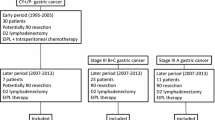Abstract
Background
This study aimed to compare the influence of colorectal laparoscopic surgery and conventional surgery on dissemination and seeding of tumor cells.
Methods
Intraoperative peritoneal lavage cytology was performed for 36 patients with colorectal cancer during colorectal laparoscopic surgery and for 45 patients with colorectal cancer during conventional surgery. Cytology was examined twice: immediately after opening of the peritoneal cavity and just before closure of the abdomen. Saline was poured into the peritoneal cavity, and 100 ml fluid was retrieved after irrigation. Laparoscopic instruments were lavaged after surgery with 100 ml of saline. Carbon dioxide (CO2) was derived through the trocar side orifice after pneumoperitoneum during laparoscopic coloectomy and filtered through 100 ml of saline. Cytologic examination of the filtrate was performed after the filtration process, smear, cell block, and staining.
Results
Malignant cells were not detected in the CO2 filtrate gas. The incidence of positive cytology in the lavage of the instruments during laparoscopic surgery was 2.78%. The incidence of positive cytology during laparoscopic surgery was 33.33% in the prelavage and 8.33% in the postlavage. The incidence of positive cytology during conventional surgery was 33.33% in the prelavage and 11.11% in the postlavage.
Conclusion
During colorectal laparoscopic surgery, CO2 pneumoperitoneum does not affect tumor cell dissemination and seeding. In this study, laparoscopic techniques used in colorectal cancer surgery were not associated with a greater risk for intraperitoneal dissemination of cancer cells than the conventional technique.
Similar content being viewed by others
References
Alexander RJ, Jaques BC, Mitchell KG (1993) Laparoscopically assisted colectomy and wound recurrence. Lancet 341: 249–250
Clinical Outcomes of Surgical Therapy Study Group (2004) A comparison of laparoscopically assisted and open colectomy for colon cancer. N Engl J Med 350: 2050–2059
Iwanaka T, Arya G, Ziegler MM (1998) Mechanism and prevention of port-site tumor recurrence after laparoscopy in a murine model [J]. J Pediatr Surg 33: 457–461
Reissman P, Teoh TA, Skinner K, Burns JW, Wexner SD (1996) Adhesion formation after laparoscopic anterior resection in a porcine model: a pilot study [J]. Surg Laparosc Endosc 6: 136–139
Sokolovic E, Buchmann P, Schlomowitsch F, Szues TD (2004) Comparison of resource utilization and long-term quality-of-life outcomes between laparoscopic and conventional colorectal surgery. Surg Endosc 18: 1663–1667
Tseng LN, Berends FJ, Wittich P, Bouvy ND, Marquet RL (1998) Port-site metastases: impact of local tissue trauma and gas leakage [J]. Surg Endosc 12: 1377–1380
Wittich P, Marquet RL, Kazemier G, Bonjer HJ (2000) Port-side metastases after CO2 laparoscopy: is aerosolization of tumor cells a pivotal factor? [J]. Surg Endosc 14: 189–192
Author information
Authors and Affiliations
Corresponding author
Rights and permissions
About this article
Cite this article
Jingli, C., Rong, C. & Rubai, X. Influence of colorectal laparoscopic surgery on dissemination and seeding of tumor cells. Surg Endosc 20, 1759–1761 (2006). https://doi.org/10.1007/s00464-005-0694-4
Received:
Accepted:
Published:
Issue Date:
DOI: https://doi.org/10.1007/s00464-005-0694-4




